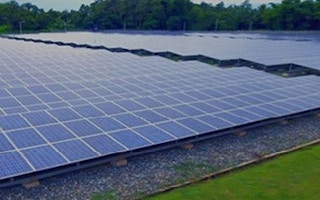Coal-fired power plants and coal energy investments were quickly approved by the government in the last two years, a move inconsistent with President Aquino’s promise to prioritize renewable energy, environment group Greenpeace said.
Greenpeace spokesperson Anna Abad said in a press conference Wednesday “an investment in coal edges out an investment in renewable energy.”
This, as the Aboitiz Power Corporation recently went on to sign a USD 546-million (PHP 22,701M) deal with contractors to build the 300-megawatt coal-fired power plant in Binugao village, this city and in Sta. Cruz town, Davao del Sur. Partial commercial operations are slated to start by the year 2015.
Abad pointed out that while President Aquino’s campaign slogan was to prioritize renewable energy, the Department of Energy (DOE) has not. In the last two years, 11 coal-fired power projects were approved by the DOE. Two more projects were given go signal with the recent US trip of President Aquino, according to Greenpeace.
Greenpeace said “any investment in dirty coal plants means investment and opportunity lost for clean and safe renewable energy systems.”
According to www.renewableenergyworld.com coal or fossil fuels are non-renewable because it draws on finite resources that will eventually dwindle, become too expensive or too environmentally damaging to retrieve. On the other hand, renewable energy resources like wind and solar energy-are constantly replenished and will never run out.
“It is high time that the people make President Aquino accountable to his promise of prioritizing renewable energy and that he should show that in his leadership for the rest of his term,” Abad said.
But during the Mindanao Energy Summit held last April, Aquino expressed that the island must instead invest in coal energy because renewable energy is expensive. Deputy presidential spokesperson Abigail Valte reportedly said that even if the DOE eyes more projects involving renewable energy like solar power, this would involve higher costs.
According to Greenpeace, while DOE says that it is ahead of its target of sourcing 50 per cent of the country’s renewable resources by the year 2030, it has difficulty in realizing actual investments for renewable energy.
Last Monday, DOE said that it had awarded 304 renewable energy contracts constituting 7,843.65 megawatts, figures that are more than the coal-fired power plants’ output of 1,935 megawatts. Green energy in the country now accounts for 58.2 per cent.
But while renewable energy soared from 26.3 per cent in 2010 to 28.4 per cent in 2011, coal energy was already at 34.4 per cent by 2010, Greenpeace said.
Ernesto Obelidhon, Supervising Science Research Specialist for the Department of Energy for Mindanao said “it is unclear” on how to transform service contracts into “real investments.”
Abad said that this remains a problem because other than the Renewal Energy Act, the DOE lacks the policy supporting renewal energy investments which includes “fiscal, non-fiscal benefits and feed-in tariffs.”
Obelidhon cited the difficulties experienced by Cagayan Electric Power and Light Company with its solar energy project in Cagayan de Oro City. Due to lack of infrastructure for transmission, the electricity generated by Cepalco’s solar energy plant is not connected to the system of the National Grid Corporation of the Philippines.
“It is not connected to the grid. It is embedded because the system of our grid may not be able to handle the generated electricity by the plant,” Obelidhon said.
The Cepalco’s solar plant is capable of producing 20 MW but fluctuates depending on the weather. Obelidhon said that energy sources like sunlight and wind are site-specific and thus maybe more expensive to deliver to the grid.
Coal contamination
Meanwhile, Dr. Jean Lindo, third nominee of the partylist group Kalikasan, said during Wednesday’s press conference that the Davao City coal-fired power plant has not provided ample research and study to ascertain the impact on health and the environment.
“A study by the Physicians for State Responsibility entitled Coal’s Assault on Human Rights in the United States says that in five to seven years, there is already contamination. The problem with the coal project here is that the Aboitiz Corporation doesn’t have a health impact assessment and baseline data on health. They could easily say that a patient may have pre-existing conditions and deny that a sickness is caused by pollutants from the plant,” Lindo said.
Juland Suazo of the environmental group Panalipdan also assailed the council’s approval of the plant. “It is the first time I have seen that a project was first approved as a whole, while other issues are ignored. Take for example, the carbon residue, where would it go?”
Even if the council already approved the construction of the coal-fired power plant, Abad of Greenpeace said that the fight of the people should not be over.
“In Subic, the people strongly opposed the coal-fired power plant and they are succeeding. We hope that the people of Davao, proud to have accessible and clean water, to host the Philippine eagle, and to have environmentally friendly policies like smoking ban, should continue the fight for environmental protection and hold public officials accountable,” Abad added.








